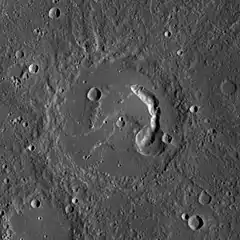 MESSENGER image | |
| Planet | Mercury |
|---|---|
| Coordinates | 3°26′N 309°46′W / 3.44°N 309.76°W / 3.44; -309.76 |
| Quadrangle | Derain |
| Diameter | 133 km |
| Eponym | Pablo Picasso |

MESSENGER WAC mosaic
Picasso is a crater on Mercury. It has drawn scientific attention because of the large, arc-shaped pit crater located on the eastern side of its floor. Similar pits have been discovered on the floors of several other Mercury craters, such as Beckett and Gibran. These pits are postulated to have formed when subsurface magma subsided or drained, causing the surface to collapse into the resulting void. If this interpretation is correct, pit-floor craters such as Picasso provide evidence of shallow magmatic activity in Mercury's history.[1]
It was named after the Spanish painter and modern artist Pablo Picasso by the IAU in 2010.[2]
Picasso lies on the north rim of the ancient Lennon-Picasso Basin.
References
- ↑ PITS, PICASSO, AND MERCURY'S HISTORY, 2010-05-25
- ↑ Picasso, Gazetteer of Planetary Nomenclature, International Astronomical Union (IAU) Working Group for Planetary System Nomenclature (WGPSN)
| Periods | |
|---|---|
| Lists of works | |
| Paintings |
|
| Sculptures |
|
| Etchings |
|
| Drawings |
|
| Lithographs |
|
| Murals | |
| Plays |
|
| Poetry | |
| Ballet designs | |
| Museums |
|
| Partners | |
| Family |
|
| Residences (France) |
|
| Films and television about |
|
| Related |
|
This article is issued from Wikipedia. The text is licensed under Creative Commons - Attribution - Sharealike. Additional terms may apply for the media files.